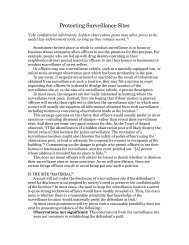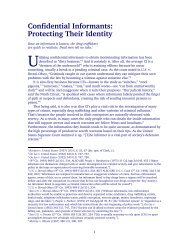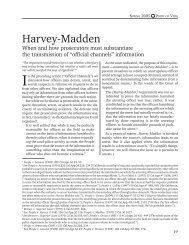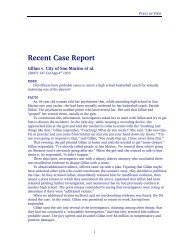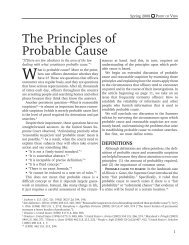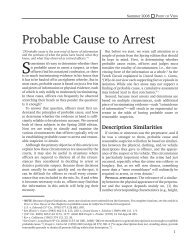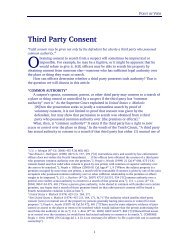Executing Search Warrants - Alameda County District Attorney's Office
Executing Search Warrants - Alameda County District Attorney's Office
Executing Search Warrants - Alameda County District Attorney's Office
Create successful ePaper yourself
Turn your PDF publications into a flip-book with our unique Google optimized e-Paper software.
attempt to plan things out is a factor that is highly relevant in determining the overall<br />
reasonableness of their conduct. 2<br />
Entry strategy<br />
There are no rigid rules that must be followed when entering. 3 Instead, the courts<br />
require only that officers enter in a reasonable manner with due regard for the safety of<br />
everyone, and the need to prevent the occupants from destroying evidence or otherwise<br />
sabotaging the search. 4<br />
KNOCK-NOTICE: <strong>Office</strong>rs must plan on complying with the knock-notice<br />
requirements unless they reasonably believe that compliance will be excused for good<br />
cause. As noted, knock-notice is covered in the accompanying article.<br />
DAMAGING PROPERTY: Planning should include a procedure for making a forced<br />
entry if need be. 5 As a general rule, a forced entry is permissible if it was reasonably<br />
necessary. In the words of the U.S. Supreme Court, “[L]aw officers constitutionally may<br />
break and enter to execute a search warrant where such entry is the only means by which<br />
the warrant effectively may be executed.” 6<br />
FLASHBANGS: If officers reasonably believe that armed resistance or destruction of<br />
evidence is likely, they may consider using flashbangs when making entry, especially<br />
before making a no-knock entry. Because officers have been using good judgment in<br />
determining when and how to use flashbangs, court authorization is not required.<br />
For example, in Langford v. Superior Court, 7 the California Supreme Court refused<br />
to require the LAPD to obtain court authorization because, (1) the department had<br />
reduced the explosive power of its flashbangs to minimize the risk of injury, (2) the<br />
department prohibited the use of flashbangs unless officers could see fully into the<br />
targeted room before tossing the flashbang inside, and (3) officers were required to<br />
obtain authorization from a police administrative panel which gave its approval only if it<br />
determined that flashbangs were the safest means of making a forcible entry.<br />
MOTORIZED BATTERING RAMS: Using a motorized battering ram to get inside is<br />
highly dangerous because, among other things, it may cause a fire by rupturing electrical<br />
or gas lines. It might even cause the building to collapse. Consequently, motorized<br />
battering rams may be used only if, (1) the issuing judge authorized it; and (2) when the<br />
ram was utilized, officers reasonably believed that evidence inside the premises was<br />
presently being destroyed, or there was an immediate threat of resistance from the<br />
occupants which posed a serious danger to officers. 8<br />
Other pre-search issues<br />
2 See, for example, U.S. v. Heldt (D.C. Cir. 1981) 668 F.2d 1238, 1261-2.<br />
3 See Wilson v. Arkansas (1995) 514 US 927, 934.<br />
4 See Wilson v. Arkansas (1995) 514 US 927, 934 [“(W)e have little doubt that the Framers of the<br />
Fourth Amendment thought that the method of an officer’s entry into a dwelling was among the<br />
factors to be considered in assessing the reasonableness of a search or seizure.”].<br />
5 See United States v. Banks (2003) 540 US __ [“Since most people keep their doors locked,<br />
entering without knocking will normally do some damage”].<br />
6 Dalia v. United States (1979) 441 US 238, 247. ALSO SEE United States v. Ramirez (1998) 523<br />
US 65, 71 [“Excessive or unnecessary destruction of property in the course of a search may violate<br />
the Fourth Amendment, even though the entry itself is lawful.”]; United States v. Banks (2003)<br />
540 US __ [“(P)olice in exigent circumstances may damage premises so far as necessary for a noknock<br />
entrance without demonstrating the suspected risk in any more detail than the law<br />
demands for an unannounced intrusion simply by lifting the latch.”].<br />
7 (1987) 43 Cal.3d 21.<br />
8 See Langford v. Superior Court (1987) 43 Cal.3d 21, 29-32.<br />
2



